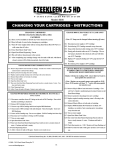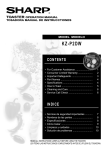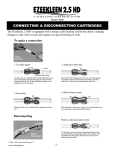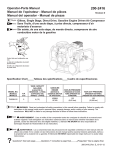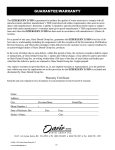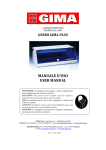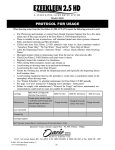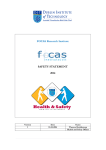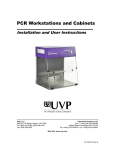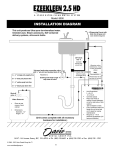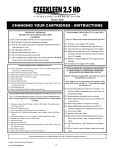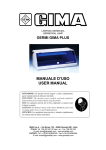Download Ezee Kleen 2.5 HD User's Manual Rev Jan 2012
Transcript
User’s Guide Please Read Before Installing & Using this Equipment 16147 - 8A Avenue, Surrey, BC, V4A 8W8 ● Ph: (800) 338-6693 ● (604) 538-1285 ● Fax: (604) 538 - 1295 2 CONTENTS FEATURES AND BENEFITS .......................................................................................................................................................4 BEFORE YOU BEGIN BEFORE USING YOUR EZEE KLEEN 2.5 HD FOR THE FIRST TIME ....................................................................................................................................... 5 INSTALLATION TOOLS REQUIRED ............................................................................................................................................................................................ 5 CHECK TO BE SURE YOU HAVE ALL THE FOLLOWING PARTS OR COMPONENTS ......................................................................................................... 5 INSTALLATION INSTRUCTIONS INSTALLATION INSTRUCTIONS ................................................................................................................................................................................................. 7 INSTALLATION DIAGRAM........................................................................................................................................................................................................... 8 FAUCET INSTALLATION .............................................................................................................................................................................................................. 9 INSTALLATION INSTRUCTIONS PROTOCOL FOR USAGE ............................................................................................................................................................................................................. 10 CHANGING YOUR CARTRIDGES - INSTRUCTIONS ............................................................................................................................................................... 11 CONNECTING & DISCONNECTING CARTRIDGES ................................................................................................................................................................. 12 MAINTENANCE SUPPLIES ......................................................................................................................................................................................................... 13 OPTIONAL FEATURES ................................................................................................................................................................................................................ 13 INTERNAL DIAGRAMS ............................................................................................................................................................................................................... 14 GUARANTEE/WARRANTY.......................................................................................................................................................15 INTRODUCTION TO WATER QUALITY POTABLE WATER QUALITY AND CONTAMINNATION PARAMETERS ............................................................................................................................. 16 SOURCE OF WATER CONTAMINANTS .................................................................................................................................................................................... 16 PRIMARY PARAMETERS ............................................................................................................................................................................................................ 16 MICROBIOLOLOGICAL GUIDELINES ....................................................................................................................................................................................... 16 CHEMICAL & PHYSICAL GUIDELINES .................................................................................................................................................................................... 18 CHLORINATION OF PUBLIC DRINKING WATER SYSTEMS ................................................................................................................................................. 18 SECONDARY PARAMETERS ...................................................................................................................................................................................................... 19 TURBIDITY & HARDNESS .......................................................................................................................................................................................................... 19 PHARMACEUTICAL GRADE WATER ....................................................................................................................................................................................... 20 USING THE EZEE KLEEN 2.5 HD TO CONTROL WATER QUALITY ..................................................................................................................................... 20 INVASIVE PROCEDURES AND UNIVERSAL PRECAUTIONS................................................................................................................................................ 21 CONTAINED DENTAL UNIT WATERLINE SYSTEMS ............................................................................................................................................................. 21 STEAM STERILIZATION OF DENTAL INSTRUMENTS........................................................................................................................................................... 22 ULTRASONIC BATHS, INSTRUMENT CLEANING & FILM DEVELOPERS .......................................................................................................................... 22 FUNCTION OF THE EZEE KLEEN 2.5 HD .................................................................................................................................................................................. 23 COMPARATIVE ASSESMENT FOR THE REMOVAL OF VARIOUS WATER POLLUTIONS ............................................................................................... 24 EFFECTIVENESS OF ULTRAVIOLET RADIATION AGAINST DIFFERENT ORGANISMS .................................................................................................. 25 ANALYTICAL REPORT ON EZEE KLEEN 2.5 HD WATER QUALITY .................................................................................................................................. 26 3 Model: 8000 FEATURES AND BENEFITS PRESENTING FOUR STAGES OF WATER PURIFICATION IN ONE SIMPLE SOLUTION STAGE 1: Prefiltration removes color, odor, taste and suspended solids STAGE 2: Reverse osmosis removes up to 98% of all organic and inorganic substances STAGE 3: De-ionization removes all remaining dissolved solids STAGE 4: Ultraviolet radiation reduces any harmful organisms FEATURES APPLICATIONS • Produces 1 gallon (4 litres) of autoclave-safe water in 4 minutes! • Autoclaves • Contained dental unit waterline systems • Reduces suspended solids (organic & inorganic) BENEFITS • Produces onsite, water of the quality necessary to comply with all autoclave manufactures TDS level guidelines (< 2.5 PPM of dissolved solids) • Ultra clean water on demand • Ensure you never run out of water for your autoclaves • Self monitors (unlike bottled water) • Eliminate last-minute store runs for water • Ultraviolet (UV) radiation reduces bacteria, viruses and other microorganisms • Eliminate bulky storage of bottles • Reduces microbial contaminants • Reduce maintenance & equipment failure • Under counter installation with designated dispensing faucet at sink • Out of sight • Consistent water quality < 2.5 PPM • Save money! 16147 - 8A Avenue, Surrey, BC, V4A 8W8 ● Ph: (800) 338-6693 ● (604) 538-1285 ● Fax: (604) 538 - 1295 © 2009 - 2012 Oasis Dental Group Inc.™ www.oasisdentalgroup.ca 4 BEFORE YOU BEGIN Before using your EZEEKLEEN 2.5 HD for the first time: • • • • allow 2 hours for Reverse Osmosis tank to fill run unit until one full tank has been emptied (10-15 minutes) allow tank to fill again output water is ready for use Installation Tools Required: • • • • • • • multi purpose screw driver electric drill 1” and 3/8"drill bit crescent wrench sharp utility knife pliers teflon tape Check to be sure you have all the following parts or components: EZEEKLEEN 2.5 HD Unit (12"w x 16"h x 6"d) • • • • Prefiltration cartridge Reverse Osmosis cartridge Ultraviolet cartridge De-ionization cartridge Power Supplies • UV cartridge power supply • monitoring system power supply Faucet (8" h) © 2009 - 2012 Oasis Dental Group Inc.™ www.oasisdentalgroup.ca 5 BEFORE YOU BEGIN Reverse Osmosis Tank • • shutoff ball valve • 4.4 gallon tank • base 15" h x 11" diameter Reverse Osmosis Drainline connection • 2 mounting bolts • • 2 mounting nuts foam washer 2 black mounting brackets • Drainline flow restrictor Input Waterline Connection Waterlines © 2009 - 2012 Oasis Dental Group Inc.™ www.oasisdentalgroup.ca 6 • 1/4” orange - input (feed) water • • 1/4” black - Reverse Osmosis drainline 3/8” black - Reverse Osmosis drainline • 1/4” blue - output to faucet • 1/4” yellow - RO tank line Model: 8000 INSTALLATION INSTRUCTIONS READ INSTRUCTIONS BEFORE COMMENCING INSTALLATION 1. Ensure unit is complete with all componentry 2. Beneath sink, turn off cold water at the shut off valve 3. Determine most suitable place to mount unit (ideally mount unit on left or right side of sink cabinet wall near the front (unit will free stand - do not fasten to the wall) allowing for removal for periodic maintenance 4. Determine most suitable place for RO tank-ideally back corner of sink cabinet 5. Ensure power supplies are within reach of unit and electrical receptacle 6. Determine most suitable place to mount faucet in countertop (allowing water to flow into sink-you will be drilling a 1” hole) 7. Ensure cold waterline is within reach of unit 8. Ensure sink drain pipe is within reach of unit 9. Install faucet in countertop (use “Faucet Installation Instructions” in this manual) 10. Determine most suitable place to connect drain pipe making sure this connection is easily accessible for routine maintenance drill 3/8" hole in drain pipe mount foam washer on inside of drain pipe bracket connect mounting brackets (2) to drain pipe with bolts/nuts tighten mounting bracket with bolts/nuts 11. Connect universal angle stop connection valve to cold waterline angle stop valve-use teflon tape remove cold water riser waterline from top of angle stop valve install universal connection valve to top of angle stop valve connect cold water riser waterline to top of universal connection valve 12. Install ball shutoff valve on tank - use teflon tape on tank screw thread place tank on mounting base place tank in back corner of sink cabinet 13. Place unit free standing with it’s back to either the left or right side cabinet wall undersink (this allows the unit to be removed and laid on it’s back in front of the sink cabinet for periodic maintenance) 14. Connect all waterlines to unit connect 1/4” blue faucet waterline to faucet stem using 1/4” quick connect fitting and to unit connect 1/4” yellow tank waterline to tank and to unit connect 1/4” black drain line from faucet to unit connect 3/8” black drain line from faucet to drain pipe connector connect 1/4” orange supply waterline to universal angle stop connection valve and to unit 15. Shorten waterlines to appropriate length—allow enough length to remove unit and set on its back in front of sink cabinet for periodic maintenance-when cutting tubing make sharp, square cuts Shorten 3/8” black drainline so that it has a reasonably direct vertical drop to drainpipe as it is gravity fed 16. Install drainline flow restrictor on 1/4” black drainline about 6” from unit 17. Turn on cold water 18. Bleed air from system by keeping tank closed and faucet open-flow from faucet will be a slow trickle (5 oz/minute) 19. Check for leaks-close faucet to maximize pressure on system 20. Auto shut off valve can be tested by closing and opening faucet-drainline flow should stop shortly after closing faucet with tank closed and should re-open when faucet is opened 21. Plug in power supplies for ultraviolet cartridge and monitoring system 22. Open tank valve and allow 2 hours for RO tank to fill 23. Run unit until one full tank has been emptied (10-15 minutes) 24. Allow tank to fill again 25. Output water is ready for use © 2009 - 2012 Oasis Dental Group Inc.™ www.oasisdentalgroup.ca 7 Model: 8000 INSTALLATION DIAGRAM This unit produces Ultra-pure de-mineralized water. Intended uses: Steam autoclaves, Self contained delivery systems, ultra-sonic baths. Dispensing Faucet with drain line air gap vent (see detailed diagram) 3/8" Drain line (maintain vertical dropgravity fed) Universal angle stop connection valve with ¼" q/c port and isolated shut off (Requires routine maintenance, mount in easily accessible place) Drain line Connector 8006 Flow restrictor (Mount in easily accessible place) A - ¼” orange poly supply line Attaches to: B - ¼" blue poly faucet line Existing Cold water angle stop shut off valve (Restricts flow to not less than 20 oz/min) C - ¼” yellow poly tank line A D - ¼" black poly drain line Shut off valve Water Reservoir Place at rear corner of sink cabinet Dimensions Diameter - 12" Height - 17" (Unit comes complete with all necessary hardware for installation.) B C Unit Dimensions LxHxD 12 x 16 x 6 Unit free stands Place near front of cabinet, turned sideways, on left or right side of sink cabinet (Do not fasten to wall) Leave sufficient water line length for unit to be laid on it’s back for routine maintenance Requires 2 - 110 V electrical receptacles (UV lamp and Monitor) 16147 - 8A Avenue, Surrey, BC, V4A 8W8 ● Ph: (800) 338-6693 ● (604) 538-1285 ● Fax: (604) 538 - 1295 © 2009 - 2012 Oasis Dental Group Inc.™ www.oasisdentalgroup.ca 8 D Model: 8000 DISPENSING FAUCET WITH DRAINLINE AIR GAP VENT Installation Instructions Faucet comes with 6 feet of ¼" and 3/8" black drainline tubing, chrome base plate and large rubber washer pre-attached to hose barbs Drainline 1" Air Gap with Vent Hole 1. Determine most suitable place to mount faucet Possible requirement of municipal code 2. Drill 1" hole in countertop 3. Slide faucet and ¼" & 3/8" drain lines into drilled hole 4. Place flat metal plate, drain line spacer and locking washer on shaft of faucet from under the counter 5. Screw hex nut onto faucet shaft and tighten firmly 6. Thread ¼" quick connect adapter connector onto faucet shaft (may use Chrome Base Plate Large Rubber Washer compression fittings if preferred) 7. Connect ¼" blue poly line into ¼" quick connect adapter connector Hose Barbs Counter Top ( 1" Hole Drilled) Large Rubber Washer Metal Washer 8. Cut 3/8" tubing to maintain reasonably direct vertical drop from faucet base to drainline connection (ie. no loops); connect to saddle valve. Plastic Spacer Lock Washer Hex Nut 9. Cut ¼" tubing to allow ample length for unit to removed from sink cabinet for periodic maintenance. ¼" Quick Connect Adapter Connector ALSO INCLUDES: Ferrule Plastic Compression Ring Compression Nut Blue ¼" Poly Faucet Line Alternative tubing connection option 16147 - 8A Avenue, Surrey, BC, V4A 8W8 ● Ph: (800) 338-6693 ● (604) 538-1285 ● Fax: (604) 538 - 1295 © 2009 - 2012 Oasis Dental Group Inc.™ www.oasisdentalgroup.ca 9 Model: 8000 PROTOCOL FOR USAGE When drawing water from the Ezee Kleen 2.5 HD ALWAYS ensure the following protocol is used: • • • • • • • • • • • • • • • Tip: Photocopy and laminate or contact Oasis Dental Customer Support line for a free laminated copy of this page and post at the Ezee Kleen 2.5 HD dispensing faucet. Water is suitable for use in autoclaves, self contained dental unit water systems, ultrasonic baths, instrument cleaning and film developers Collect and store Ezee Kleen 2.5 HD autoclave safe water in clean containers marked “Autoclave Water Only” “No Tap Water” “Keep Lid On” “Store Only 48 Hours” Label the Dispensing Faucet "Autoclave Water - Always Check Monitor while Drawing Water" Disregard monitor when not dispensing water from the unit (ie. when unit sits idle) Check Ezee Kleen 2.5 HD Monitor each time water is drawn Regularly inspect the containers for cleanliness When storing filled containers ensure caps remain on Avoid storing or drawing water in an unclean environment Avoid storing the water more than 48 hours Ensure the working area around the dispensing faucet and especially the dispensing faucet itself remains clean Avoid running equipment that has the potential to create dust or particulate matter in the atmosphere when drawing water Use “Patient Scheduler” to schedule maintenance for Ezee Kleen 2.5 HD annually See page 11 of user’ manual for “Changing your Cartridges – Instructions” Failure to comply with manufacturer’s “Protocol for Usage” and below maintenance recommendations could result in water not suitable for intended use Cartridge 8002-FR DI Cartridge with drainline flow restrictor 8003 Pre-Filter 8004 RO Membrane Maintenance Change when monitor reads > 5.00 with water flowing (red light will begin to flash as a secondary indication) Change Annually Change Bi-annually (Every Two Years) 8005 UV Lamp Change Annually Last maintained Changed by Cartridge Supplier: Staff member responsible for maintenance of the Ezee Kleen 2.5 HD: Questions? Contact customer support Mon – Fri, PST, 8:00am – 5:00pm. 16147 - 8A Avenue, Surrey, BC, V4A 8W8 ● Ph: (800) 338-6693 ● (604) 538-1285 ● Fax: (604) 538 - 1295 © 2009 - 2012 Oasis Dental Group Inc.™ www.oasisdentalgroup.ca 10 Model: 8000 CHANGING YOUR CARTRIDGES - INSTRUCTIONS CHANGING CARTRIDGES BEFORE CHANGING 8002-FR, 8003 or 8004 CARTRIDGE A.1 Have a towel available to absorb any water released by system CHANGE 8005 ULTRA-VIOLET (UV) LAMP ANNUALLY (Note: UV Lamp can be changed without turning off water) A.2 Have full tank of water before changing any cartridges A.3 Turn off water supply under sink by closing Ezee Kleen Shut Off Valve or D.1 Disconnect power supply to UV Cartridge D.2 Swivel/swing UV Cartridge outwards away from unit cold water shut off valve D.3 Grasp white electrical cable exiting end of UV Cartridge A.4 Close Ezee Kleen Tank Valve D.4 Gently pull electrical cable out of UV Cartridge - The en- A.5 Open Ezee Kleen Dispensing Faucet tire lamp is attached to the electrical cable and will slide A.6 This will relieve line pressure in the system A.7 After completing any cartridge change wait for tank to fill and, with faucet closed, system will be fully pressurized, check for leaks out of UV Cartridge D.5 Replace UV Lamp by sliding new UV Lamp into the UV Cartridge D.6 Re-connect power supply to UV Cartridge CHANGE 8003 PRE FILTER CARTRIDGE ANNUALLY B.1 Remove Slip-in-Elbow from both ends of cartridge - Consult User’s Guide to understand quick connect feature on all Ezee Kleen fittings B.2 Remove protective dust plugs from new cartridge B.3 Replace expired cartridge ensuring water is flowing in the correct direction CHANGE 8002-FR DI CARTRIDGE IF MONITOR IS FLASHING WHILE WATER IS BEING DISPENSED FROM EZEE KLEEN DISPENSING FAUCET Monitor will also be reading >5.00 - Above this level water is unacceptable for autoclave use B.4 Reinsert Slip-in-Elbows to both ends of cartridge B.5 Turn on water supply B.6 Open Ezee Kleen Tank Valve B.7 Run water from Ezee Kleen Dispensing Faucet until you have a steady stream of water - Continue until tank is empty (Note: Monitor can accurately gauge water quality to 19.99. Above 19.99 monitor will show “1 .” and is still unacceptable for autoclave use) B.8 Close Dispensing Faucet E.1 Remove Slip-in-Elbow from both ends of cartridge - Con- B.9 Allow 2 hours for tank to fill again - System is now ready to use sult User’s Guide to understand quick connect feature on CHANGE 8004 REVERSE OSMOSIS (RO) MEMBRANE BI-ANNUALLY (Every 2 years) (Note: Do not replace 8002-FR DI Cartridge at same time as replacing 8004 RO Membrane. Empty, and refill one full tank of water through new RO Membrane prior to changing 8002-FR DI cartridge) C.1 Disconnect waterlines from all 3 fittings at the ends of RO Cartridge - Note which waterline all Ezee Kleen fittings E.2 Remove protective dust plugs from new cartridge E.3 Replace expired cartridge ensuring water is flowing in the correct direction E.4 Reinsert Slip-in-Elbows to both ends of cartridge E.5 Replace 8006 Drainline Flow Restrictor on black 1/4” each fitting is attached to C.2 Remove RO Cartridge from clips drainline, ensuring arrow is pointing away from the unit C.3 Unscrew cap of RO Cartridge and discard expired RO Membrane C.4 Clean inside of RO Cartridge with mild detergent - Rinse thoroughly - Insert new RO Membrane E.6 Turn on water supply E.7 Open Ezee Kleen Tank Valve E.8 Run water from Ezee Kleen Dispensing Faucet until you C.5 Screw on RO Cartridge cap - Do not over tighten - Fit RO Cartridge back into clips have a steady stream of water - Continue until tank is C.6 Reconnect all 3 waterlines to fittings on RO Cartridge C.7 Turn on water supply empty C.8 Open Ezee Kleen Tank Valve C.9 Run water from Ezee Kleen Dispensing Faucet until you have a steady stream of water - Continue until tank is empty E.9 Check that monitor is < 5.00. Monitor will stop flashing red E.10 Allow 2 hours for tank to fill again- System is now ready C.10 Close Dispensing Faucet to use C.11 Allow 2 hours for tank to fill again - System is now ready to use Call Oasis Dental Group Inc. @ (800) 338-6693, M-F, 8:00 - 5:00 PST for technical assistance. © 2009 - 2012 Oasis Dental Group Inc.™ www.oasisdentalgroup.ca 11 Model: 8000 CONNECTING & DISCONNECTING CARTRIDGES The Ezeekleen 2.5 HD is equipped with a unique collet locking system that allows cartridge changes to take only seconds and requires no special training or tools. To make a connection 1. Cut tube square 3. Push up to tube stop Cut tube square. It is essential that the outside diameter be free of score marks and that burrs and sharp edges be removed before inserting into fitting. For soft thin walled plastic tubing we recommend the use of a tube insert. Push the tube into the fitting to the tube stop. The collet (gripper) has stainless steel teeth which hold the tube firmly in position while the ‘O’ ring provides a permanent leak proof seal. 4. Pull to check secure 2. Insert tube Fitting grips before it seals. Ensure tube is pushed into the tube stop. Pull on the tube to check that it is secure. It is a good practice to test the system prior to leaving site and/or before use. Disconnecting Push in collet and remove tube To disconnect, ensure the system is depressurized before removing the tube. Push in collet squarely against face of fitting. with the collet held in this position, the tube can be removed. The fitting can then be reused. © 2009 - 2012 Oasis Dental Group Inc.™ www.oasisdentalgroup.ca 12 MAINTENANCE SUPPLIES TO ORDER YOUR SUPPLIES 1) Contact your authorized EZEEKLEEN 2.5 HD dealer. For easy reference, enter your Dealer’s name and contact information here: Or 2) Contact Oasis Dental Group at: (800) 338-6693 or (604) 538-1285 Fax: (604) 538-1295 Mail: 16147 - 8A Avenue, Surrey, BC V4A 8W8 Website: www.oasisdentalgroup.ca Email: [email protected] EzeeKleen 2.5 HD - Complete Unit - # 8000 De-ionization Cartridge - #8002-FR (includes 8006 flow restrictor) • change cartridge when monitor reads > 5.00 µs with water flowing (red light will begin to flash as a secondary indication) water is greater than 2.5 PPM (mg/L) of dissolved solids and is unsafe to use in autoclave. Change 8006 Flow Restrictor each time 8002-FR is changed. XL De-ionization Cartridge (Optional) - #8002-XL • change cartridge when changing 8002-FR Prefiltration Cartridge - # 8003 • • change annually not to exceed 2,000 gallons Reverse Osmosis Membrane - # 8004 • change bi-annually (every two years) Ultraviolet Lamp - # 8005 • • ultraviolet cartridge will have a noticeable blue illumination when operating. Change the lamp if the illumination ceases, or change annually, not to exceed 9,000 hrs of continuous use Drainline Flow Restrictor—Part #8006 • change when changing 8002-FR DI cartridge OPTIONAL FEATURES • XL De-ionization Install Kit - #8002-XL-KIT • • • Order for initial XL DI Cartridge install (8002-XL DI Cartridge included) Optional tank sizes available Total Dissolved Solids Tester (Handheld) For water testing contact Oasis Dental Group or a local water testing facility. © 2009 - 2012 Oasis Dental Group Inc.™ www.oasisdentalgroup.ca 13 Model: 8000 INTERNAL DIAGRAM FEED FAUCET TANK DRAIN Front Port Back Port OUT TANK IN TANK 16147 - 8A Avenue, Surrey, BC, V4A 8W8 ● Ph: (800) 338-6693 ● (604) 538-1285 ● Fax: (604) 538 - 1295 © 2009 - 2012 Oasis Dental Group Inc.™ www.oasisdentalgroup.ca 14 GUARANTEE/WARRANTY The EZEEKLEEN 2.5 HD is guaranteed to produce the quality of water necessary to comply with all autoclave/steam sterilizer manufacturer’s TDS (total dissolved solids) requirements when used in accordance with manufacturer’s directions. Liability is limited to autoclave/sterilizer boiler repair or replacement while under manufacturer’s warrantee upon given proof manufacturer’s TDS requirements have not been met when the EZEEKLEEN 2.5 HD has been used in accordance with manufacturer’s (Oasis) directions. For a period of one year, Oasis Dental Group Inc. guarantees the EZEEKLEEN 2.5 HD to be free of defects due to workmanship including all components (with the exception of the De-ionization, Prefiltration, Reverse Osmosis, and Ultraviolet cartridges) when delivered to the customer in new, unused condition by an acknowledged dealer of Oasis Dental Group Inc. products. In the event of failure due to such defects, within this period of time, the exclusive remedies shall be repair or replacement, at Oasis Dental Group Inc.’s option and without charge, of any defective part(s) provided to Oasis Dental Group Inc. in writing within thirty (30) days of the date of such failure and further provided that the defective part(s) are returned to Oasis Dental Group Inc. freight prepaid. Any express warranty not provided here on, or any implied warranty or representation as to the performance which may arise by implication not in this provision for the EZEEKLEEN 2.5 HD is excluded and disclaimed by Oasis Dental Group Inc. Warranty Certificate Keep this and your original invoice of purchase in your permanent records for proof of warranty. Name: Address: City: Province/State: Phone Number: ( ) Date of Purchase: Mo: Postal/Zip: Day: Year: Dealer’s Name: City: 16147 - 8A Avenue, Surrey, BC, V4A 8W8 ● Ph: (800) 338-6693 ● (604) 538-1285 ● Fax: (604) 538 - 1295 © 2009 - 2012 Oasis Dental Group Inc.™ www.oasisdentalgroup.ca 15 INTRODUCTION TO WATER QUALITY POTABLE WATER QUALITY AND CONTAMINATION PARAMETERS Sources of Water Contaminants Sources of drinking water worldwide include rivers, lakes, streams, ponds, reservoirs, springs and wells. As water travels over the surface of the land or through the ground, it dissolves naturally occurring minerals and, in some cases, radioactive material, and can pick up substances resulting from the presence of animals or from human activities. Contaminants that may be present in source water include: microbial contaminants; inorganic contaminants; pesticides and herbicides; organic chemical contaminants; and radioactive contaminants. Some of the more common sources of substances in water are: erosion of natural deposits, naturally occurring elements, road salt, organic sources such as algae, corrosion of household plumbing systems, leaching from wood preservatives, water additives to promote strong teeth, run-off from fertilizer, decay of natural deposits, man made emissions, leaching from septic tanks, sewage, water softeners, animal waste, soil run-off, by-products of drinking water chlorination, discharge from dry-cleaners, residue from cleaning solvents and metal degreasers, emissions from solvents, chemical intermediates, blowing agents for polyurethane foams, aerosol propellants, fire extinguishing agents, plasticizers from flexible plastics, run-off from herbicide use, human and animal fecal waste, residue from washing detergents, run-off from pesticide use and additives to gasoline in the winter. This list is not necessarily exhaustive. In order to ensure that tap water is safe to drink, state, provincial and federal health authorities prescribe regulations which limit the amount of certain contaminants in water provided by public water systems. Water quality is monitored over a wide spectrum of microbiological, chemical and physical measures of quality. All public water utilities are required to monitor the quality of water they distribute according to these regulations. Water quality is typically monitored at the source (river, lake, stream, etc.), at the treatment facilities and throughout the distribution system delivering water to the customers point of use. Drinking water may reasonably be expected to contain at least small amounts of some contaminants. The presence of contaminants does not necessarily indicate that water poses a health risk. More information about contaminants and potential health effects can be obtained by calling, in the United States, the Environmental Protection Agency’s Safe Drinking Water Hotline and in Canada, the Health Protection Branch of Health Canada. Contact information can be obtained from your local government authority. Primary Parameters Microbiological Guidelines Microbiological guidelines exist to control the presence of pathogenic or disease-causing micro-organisms. Pathogenic microorganisms that occur in polluted water include protozoa, bacteria and enteric viruses. The most common disease attributable to waterborne pathogenic micro-organisms is gastrointestinal illness or diarrhea. Although gastrointestinal illness is generally considered to be non-life threatening in normal healthy adults, mortality can occur in sensitive subpopulations, such as infants, the elderly and immunosuppressed individuals. Microbiological guidelines usually establish baseline quantities for total coliforms, faecal coliforms and heterotrophic plate counts or background colony counts. Normally the guidelines will establish appropriate actions to be taken if baseline quantities are exceeded. Retesting to confirm baseline quantities are not being exceeded is normally expected after corrective action has been taken. All drinking water supplies should be analyzed routinely for coliform bacteria and the general bacterial population. The presence of excess total coliforms, as stated below, in drinking water indicates that treatment is inadequate or that the distribution system is experiencing re-growth or infiltration. Total coliforms are not necessarily an indication of the presence of fecal contamination. Faecal coliforms in drinking water may, however, indicate the presence of faecal © 2009 - 2012 Oasis Dental Group Inc.™ www.oasisdentalgroup.ca 16 INTRODUCTION TO WATER QUALITY contamination. The presence of Escherichia coli (“E.coli”), one species in the faecal coliform group, is a definite indicator of the presence of faeces. Other species in the faecal coliform group (e.g. Klebsiella pneumoniae, Enterobacter cloacae) are not restricted to faeces but occur naturally on vegetation and in soils. The general bacterial population can be estimated from either background colony counts on total coliform membrane filters or heterotrophic plate counts (“HPC”), as outlined in the 16th edition of Standard Methods for the Examination of Water and Wastewater. Excessive concentrations of the general bacterial population may hinder the recovery of coliforms and thereby prevent the detection of a potential threat to public health. Typically the maximum acceptable concentration for coliforms in drinking water is zero organisms detectable per 100mL. Because coliforms are not uniformly distributed in water and are subject to considerable variation in enumeration, authorities typically regulate that drinking water that fulfills the following conditions is considered to be in compliance: 1. No sample should contain more than 10 total coliform organisms per 100 mL, none of which should be faecal coliforms; 2. No consecutive sample from the same site should show the presence of coliform organisms; and 3. For community drinking water distribution systems: a. not more than one sample from a set of samples taken from the community on a given day should show the presence of coliform organisms; and b. not more than 10% of the samples based on a minimum of 10 samples should show the presence of coliform organisms. 4. No sample should contain more than 500 HPC colonies per millilitre or more than 200 background colonies on a total coliform membrane filter (i.e. overgrowth) 5. The confirmed presence of E. coli in drinking water should trigger an immediate “boil water advisory”. Recent Outbreaks of Waterborne Infections Two protozoans of recent particular concern are Giardia cysts and Cryptosporidium oocysts. Outbreaks of Giardiasis occurred in a number of locations in British Columbia and Washington State in the late 1980s. In the spring of 1993 an outbreak of waterborne disease occurred in Milwaukee, Wisconsin, where an estimated 400,000 people became ill with Cryptosporidiosis. Several other North American communities have experienced Cryptosporidiosis outbreaks in the recent past. Cryptosporidiosis, is more serious than Giardiasis as it is untreatable and can cause life threatening illness in those individuals at high risk such as the elderly and those with compromised immune systems. Cryptosporidium is very resistant to the effects of chlorine and therefore water systems with unfiltered surface supplies that rely on chlorination disinfection alone, may be unable to decrease the risk of this disease if significant numbers of the organism are present in the source water. In May 2000 in Walkerton, Ontario an estimated 2,000 people grew ill from an outbreak of E.coli infection. People became sick with fever, cramps, nausea and bloody diarrhea. Seven people died and an investigation found 1,346 confirmed cases of gastroentreritis were reported to medical officials. It is believed that heavy rain likely washed cattle manure laced with E. coli into one of the town’s deep well supplies. Testing of 13 livestock farms near the wells found E. coli on two of them and other bacteria harmful to people on all but two. These types of outbreaks reinforce the need for adequate disinfection and consistent monitoring throughout public water distribution systems. As an example, the City of New York in 1999 had nearly 1000 fixed sampling stations throughout the city from which it draws samples for monitoring purposes. While not common, waterborne disease outbreaks have occurred and people can be at risk. Again, sensitive subpopulations, such as infants, the elderly and immunosuppressed individuals can be expected to be at greater risk. © 2009 - 2012 Oasis Dental Group Inc.™ www.oasisdentalgroup.ca 17 INTRODUCTION TO WATER QUALITY Chemical and Physical Guidelines Guidelines exist to control the presence of chemical and physical elements in public water systems. Chemical and physical elements in public water systems may be undesirable for a number of reasons. Chemicals are normally classified according to data on carcinogenicity. Different approaches are adopted for the derivation of guidelines for compounds considered to be carcinogenic and probably carcinogenic, compounds considered to be possibly carcinogenic and those considered to be probably not carcinogenic or for which data were inadequate for evaluation. Lead poisoning is of particular concern, especially for infants and young children. Water being delivered to public water distribution systems is likely to be leadfree, but water can absorb lead from solder, fixtures, and pipes found in the plumbing of some buildings or homes. Iron, copper and manganese are elements undesirable in water in higher quantities. People on severely restricted sodium diets or moderately restricted sodium diets should concern themselves with sodium levels in public water supplies. Guidelines for chemical and physical parameters are extensive and in some jurisdictions exceed as many as eighty parameters. New parameters are reviewed on an ongoing basis and guidelines undergo continual updates. To determine locally which parameters are monitored and their benchmark guidelines contact the water quality department of your water supply utility and request a “Water Quality Report”. In the United States, the USEPA National Primary Drinking Water Regulations, and in Canada the Health Canada Guidelines for Canadian Drinking Water Guidelines stipulate the parameters and benchmarks for which drinking water must be controlled. Contaminants that may adversely affect public health and occur in drinking water with a frequency and at levels that pose a threat to public health are constantly reviewed. A maximum contaminant level goal is established, below which there is no known or expected risk to health. Next, a maximum contaminant level is established. This is the maximum permissible level of a contaminant in drinking water which is delivered to any user of a public water system. These levels are enforceable standards, and are set as close to the goals as feasible. Some conventional physical and chemical contaminants that are regulated are antimony, arsenic, asbestos, barium, beryllium, cadmium, chromium, copper, cyanide, fluoride, gross alpha particle, iron, lead, mercury, nickel, nitrate, nitrite, selenium, silver, sulphide, thallium. There are numerous regulated organic contaminants, a few of which are chloramines, dichlorethylenes, tetrachloroethylenes, trichloroethene, and trichlorofluromethanes. Recent attention has been drawn to the chemical MTBE (methyl tertiary butyl ether), an oxygenate widely used as a gasoline fuel additive. MTBE has been found mainly in ground water supplies as a result of leaking gasoline storage tanks and pipelines. The potential for MTBE groundwater contamination is exacerbated by its solubility in water, which allows it to travel through groundwater aquifers faster than the other, less soluble, components of gasoline. The chemical has also been detected at much lower levels in surface water supplies, due more to air emissions and recreational power boating, than to leaking underground storage tanks. Chlorination of Public Drinking Water Systems The chlorination of water creates differences in the characteristics of treated water versus raw water. When gaseous chlorine is added to water, it quickly hydrolyzes to form hypochlorous acid and hydrogen and chloride ions. This reaction results in a drop in pH and alkalinity with a subsequent increase in the level of chloride in the water. These changes increase the corrosiveness of water, especially in areas where water may already be corrosive due to natural low pH, low alkalinity and high dissolved oxygen. In these situations it is not uncommon to see at the tap elevated levels of copper and lead, both of which leach from household plumbing. These problems can be further exacerbated in older buildings, particularly buildings with hot water heating systems and galvanized piping. Chlorination of water supplies, either using liquid chlorine or bleach, leads to the formation of undersirable Disinfection By-Products (“DBP’s”) through reaction of chlorine with natural organic matter (“NOM”) present in raw water. Among the DBP’s formed are trihalomethanes (“THM’s”), haloacetic acids (“HAA’s”), chloral hydrates, haloacetonitriles and chloropicrin. THM’s and HAA’s are present in significant concentrations in chlorinated waters. Factors affecting the formation of DBP’s are chlorine concentration, pH, temperature, bromide, contact time, and the nature and concentration of NOM. NOM consists of total and dissolved organic carbon (“TOC” and “DOC”) caused by decaying vegetation in water. © 2009 - 2012 Oasis Dental Group Inc.™ www.oasisdentalgroup.ca 18 INTRODUCTION TO WATER QUALITY This material has potentially negative effects on water quality. TOC exerts a chlorine demand, that is, chlorine reacts with the organic material in the water resulting in a loss of chlorine residue over time and the production of potentially undesirable DBP’s. Chloroform, one THM, is the THM detected most frequently and at highest concentrations in drinking water. Chloroform’s volatility creates the potential for exposure to airborne chloroform released from tap water. Available data are consistent with the hypothesis that ingestion of chlorinated drinking water may be causally related to cancers of the bladder and colon. Chloroform has been found to be carcinogenic in two animal species and has been classified as being probably carcinogenic to humans. Secondary Parameters Turbidity Turbidity is a measure of cloudiness of the water. Turbidity is monitored because it is a good indicator of water quality and can hinder the effectiveness of disinfection. Turbidity in water is caused by suspended matter, such as clay, silt, finely divided organic and inorganic matter, soluble colored organic compounds, plankton and other microscopic organisms. Turbidity measurements relate to the optical property of a water that causes light to be scattered and absorbed rather than transmitted in straight lines through the sample. The current method of choice for turbidity measurement is the nephelometric turbidity unit (“NTU”). Excessive turbidity detracts from the appearance, taste and odors of water. It can serve as a source of nutrients for waterborne bacteria, viruses and protozoa, which can be embedded in or adhere to particles in the raw water or become trapped within floc formed during water treatment; turbidity can thus interfere with the enumeration of micro-organisms in finished water, as the microorganisms may not be detectable or may be grossly underestimated by current detection methods. The adsorptive properties of suspended particles can also lead to a concentration of heavy metal ions and biocides in turbid waters. Turbidity can interfere with disinfection processes and the maintenance of a chlorine residue. Turbidity has also been related to trihalomethane formation in chlorinated water. Viable coliform bacteria have been detected in waters with turbidities higher than 3 NTU, even in the presence of free chlorine residuals. Typically, turbidity guidelines are set at 1NTU for water entering the distribution system (post treatment) and 5 NTU at the point of consumption. However, periodic flushing of the water mains by water utilities may dramatically increase the mains water turbidity for a temporary period. Hardness In the United States, the USEPA and in Canada, Health Canada have established a secondary standard for total dissolved solids in public water systems of 500 mg/L. (1 mg/L = 1 PPM). The source of dissolved solids is typically metals and salts naturally occurring in soil and organic matter. Dissolved solids, while not necessarily harmful to humans, contribute to excessive hardness, mineral deposition, corrosion and taste in water. Water hardness is caused by dissolved polyvalent metallic ions, principally calcium and magnesium, and is expressed as the equivalent quantity of calcium carbonate. Encrustation and excessive soap consumption are the main concerns with hardness. On heating, hard waters have a tendency to form scale deposits. While not typically a regulated parameter, most public water utilities report levels of hardness. Water with 0 - 50 mg/L of hardness is considered soft, between 51 - 151 mg/L is moderately hard and water having (150 mg/L is generally considered to be hard. © 2009 - 2012 Oasis Dental Group Inc.™ www.oasisdentalgroup.ca 19 INTRODUCTION TO WATER QUALITY PHARMACEUTICAL GRADE WATER The term pharmaceutical grade water is often used as a collective term for six types of water as defined by the United States Pharmacopeial Convention Inc. (“USP”): • • • • • • purified water; water for injection; bacteriostatic water for injection; sterile water for inhalation; sterile water for injection; and sterile water for irrigation. Currently USP 23 defines “Purified Water” according to the following monographs: • pH 5 to 7 • Total Organic Carbons 500 PPB • Conductivity (µS/cm) • Stage 1 ≤ 1.3 µS/cm (on-or off line; T > 25° C [77°F]) • Stage 2 ≤ 2.4 µS/cm (off line; T = 24 to 26° C [75 to 79° F]) • Stage 3 ≤ 2.4 to 5.8 µS/cm (off line; T = 24 to 26° C [75 to 79° F]) • Source water USEPA NPDWR • Microbiological Concentrations: Recommended “action” limit = 100 CFU/mL. Water meeting these requirements can be labeled as Pharmaceutical Grade Purified Water. While water of this quality may be desirous it is extremely difficult to obtain and is limited by feasibility. Onsite water purification systems may be able to produce water of this quality by a number of processes but numerous factors will influence the systems ability to maintain production of water of this quality on a consistent and reliable basis. Onsite water purification systems are susceptible to, among other things, source water parameter variations, system performance, system maintenance, operator care and post production handling. USING YOUR EZEEKLEEN 2.5 HD TO CONTROL WATER QUALITY PARAMETERS OF CONCERN TO THE DENTAL OFFICE Water is used in the dental office for a number of purposes beyond that of drinking water. Much of today’s dentistry is performed using instruments cooled by water. Specifically, both the high-speed handpiece and the ultrasonic scaler use water as a driving/ cooling agent. The triplex syringe uses water to flush the patients mouth of debris and provide irrigation. Water is commonly used for steam sterilization of instruments. Film developers, ultrasonic baths and instrument cleaning are other sources of water use in the dental office. Until now the only source of specialized water for the dental office has been purchased water either, through a retail outlet or by a delivery service. The EZEEKLEEN 2.5 HD uses four sophisticated water purification processes to produce an ultra clean quality water. The unit is designed to further process potable water (meeting NPDW regulations) on site, on demand, at an affordable price and eliminates the need to store water in bottles which promote microbiological re-growth. Contaminants taken into consideration in the design of the EZEEKLEEN 2.5 HD include: micro-biological contaminants, inorganic contaminants, pesticides and herbicides, organic chemical contaminants and radioactive contaminants. Water produced may, under certain conditions, meet the definition of Pharmaceutical Grade Purified Water. All of the monographs of USP 23’s definition of Purified Water have been taken into consideration in the design of the EZEEKLEEN 2.5 HD. Parameters outside of the control of the design of the unit are, among other things: source water parameter variations, system maintenance, user care and attention, and post production handling of water produced by the unit. With appropriate protocols and regular testing users may be able to achieve Pharmaceutical Grade Purified Water from their EZEEKLEEN 2.5 HD. © 2009 - 2012 Oasis Dental Group Inc.™ www.oasisdentalgroup.ca 20 INTRODUCTION TO WATER QUALITY Invasive Procedures and Universal Precautions Modern dentistry involves many invasive procedures. Many procedures involve the cutting of soft tissue or bone and direct exposure to the patients blood stream. Teeth cleaning predominantly uses ultrasonic scaling to remove stain and tartar high up under the patients gums creating a direct access to the blood stream. Today’s population includes many sensitive subpopulations of greater risk to pathogenic organisms and water contaminants. The use of chemotherapy for cancer treatment has grown enormously creating an immunocompromised group that did not exist only a few decades ago. New treatments for diseases such as cancer, aids, cystic fibrosis, diabetes, etc. are extending the lives of people inflicted with such diseases, but additionally creating new subpopulations of immunocompromised individuals as they live longer. The maturing of North America’s baby boom generation is creating an explosion of elderly people more susceptible to compromised immune systems. Modern medicine is helping these people live longer, and as they get older they spend more years in which their immune systems are compromised. Modern medicine, chemistry and microbiology has made us more aware of other potential risks that were previously unknown. We are now aware of the hazards of lead poisoning coming from the leaching of lead in our household plumbing. Exposure to high levels of copper, manganese and iron are not necessarily desirable. Public water systems high in sodium content may not be appropriate for people on sodium reduced diets. New carcinogens are being discovered daily. It is difficult for the practitioner to have a complete understanding of the patients medical history, thus making it more difficult to identify the patient requiring extra precautions. More and more practitioners are gaining an appreciation of potential contaminants in municipal water supplies and an understanding of the difficulty public water treatment systems are having in removing and monitoring all of them. Consequently, practitioners may deem it not appropriate to use municipal water in the dental operatory. Contained Dental Unit Waterline Systems Bacterial growth and proliferation in dental lines supplying water to high speed handpieces, triplex syringes and ultrasonic scalers has become of recent concern. In North America, the American Dental Association and Canadian Dental Association have both addressed the issue with official position statements. The profession has challenged manufacturers to work towards a goal of no more than 200 colony forming units (“CFU”)/mL of water emitted from dental unit waterlines. State and provincial dental associations are starting to address the issue. In the United States, the Occupational Safety & Health Association (“OSHA”) has mandated that no more than 200 CFU/mL of legionella should be present in water being emitted from dental waterlines. The Center for Disease and Control is considering updating its guidelines for dental waterlines. Media attention is being drawn to the issue with coverage from such prominent players as ABC’s “20/20” Investigative News Program. Studies suggest that few dental waterline systems would meet these guidelines without additional disinfection equipment and/or adequate disinfection protocols. For further information on dental unit water contamination contact Oasis Dental Group Inc. @ 800-338-6693, visit internet site www.safedentalwater.org or contact your state/provincial or federal dental association. One such potential solution to dental unit water contamination has been the introduction of contained (closed) dental unit water systems which operate independent from the municipal water supplies. These systems provide a reservoir to contain the water supplying the dental unit waterlines. This reservoir allows the user to control the quality of water entering the dental waterlines and provides a point of access to introduce disinfectant products into the system to attempt to control microbiological contamination. These systems also negate the need for backflow preventors on each dental operatory, a common requirement of many municipalities. The use of EZEEKLEEN 2.5 HD water in contained dental unit water systems offers several benefits. Dental unit water contamination predominantly originates from low levels of bacteria present in municipal water supplies. These bacteria © 2009 - 2012 Oasis Dental Group Inc.™ www.oasisdentalgroup.ca 21 INTRODUCTION TO WATER QUALITY enter the dental waterlines and adhere to the walls of the waterlines. To survive and multiply the bacteria extract food and nutrients in the form of organic matter and inorganic minerals to develop and build an ecosystem in which they can thrive. EZEEKLEEN 2.5 HD water is processed to minimize microbiological contamination thus minimizing the number of organisms being introduced into the system. Furthermore, EZEEKLEEN 2.5 HD water has little if any organic matter or inorganic minerals present in it, thus minimizing the food supply that bacteria need to build their ecosystem. While using EZEEKLEEN 2.5 HD water alone may not be enough to prevent microbiological growth in dental unit waterlines it will help to reduce the rate of growth and reduce the frequency of chemical treatment protocols on dental waterlines. Reduced chemical treatment means less patient exposure to chemicals, less equipment exposure to harsh chemicals, less staff time performing disinfection protocols on waterlines and less cost on chemical treatment products and protocols. Another potential solution to dental unit water contamination is the use of microfiltration. Microfiltration cartridges with pore sizes as small as 0.22 micron are available on the market for dental waterlines. While the membranes of these microfiltration cartridges offer a physical barrier to impede the flow of bacteria down the dental waterline they are subject to clogging from two sources: suspended and dissolved solids in municipal water supplies; and, organic growth and bacterial growth in the biofilm in dental waterlines. EZEEKLEEN 2.5 HD water offers a source of water void of the typical suspended and dissolved solids found in municipal water. Secondly, EZEEKLEEN 2.5 HD water has little if any organic matter or inorganic minerals present in it, thus minimizing the food supply for which bacteria need to build their ecosystem. This will assist in retarding the development of biofilm on dental waterlines. Because of these factors, the use of EZEEKLEEN 2.5 HD water will improve the performance and life of dental unit waterline microfiltration cartridges by reducing the level of contaminants with which they are challenged. Steam Sterilization of Dental Instruments Steam Sterilization has become the method of choice for sterilizing instruments in the dental office because they offer excellent penetration and relatively short cycles. Water-based liquids can also be sterilized by steam sterilization. There are two types of steam sterilizers common to the dental office: conventional systems; and, cassette-style rapid steam heat. Conventional systems normally operate at 121° C for at least 20 minutes. Cassette-style rapid steam sterilizers normally operate at 135° C for 5 minutes. Water used in steam sterilizers typically enters a relatively small boiler chamber where it is heated to specified temperatures and evaporates. Instruments are subjected to this heated vaporized steam thereby killing any microbial or viral contaminants present. Impurities in the supply water for the sterilizer, remain in the boiler chamber as a residue. This residue can foul the boiler chamber of a steam sterilizer, shorten it’s life and cause it to malfunction or fail completely. Most steam sterilizer manufacturers recommend that water with no more than 5 mg/L of Total Dissolved Solids be used. Additionally, some dissolved solids can be carried with the vaporized water to the instruments and cause pitting, especially on non-stainless steel metals. The EZEEKLEEN 2.5 HD is designed to provide a very high grade of water suitable for use in all steam sterilizers in the dental office. Water processed by the EZEEKLEEN 2.5 HD has little if any impurities and accordingly, can promote more efficient, effective operation and longer life of the steam sterilizer. Additionally, EZEEKLEEN 2.5 HD water minimizes the risk of instrument pitting from steam sterilization. The EZEEKLEEN 2.5 HD constantly monitors water quality to ensure it has less than 2.5 mg/L of Total Dissolved Solids present. Ultrasonic Baths, Instrument Cleaning & Film Developers The EZEEKLEEN 2.5 HD produces an ultra clean quality water free from suspended solids and dissolved solids. These contaminants are often the cause of instrument pitting and deterioration and can potentially influence the quality and clarity of x-rays used in the dental office. © 2009 - 2012 Oasis Dental Group Inc.™ www.oasisdentalgroup.ca 22 INTRODUCTION TO WATER QUALITY FUNCTION OF EZEEKLEEN 2.5 HD The EZEEKLEEN 2.5 HD has been designed to further process potable water (meeting NPDW regulations) through four stages of purification to produce a very high grade of water. Each of the stages is described below. Oasis Pre-Filtration Cartridge. Most municipal water contains chlorine, suspended solids1 and dissolved organic solids2 that may foul Reverse Osmosis (RO) filters and deionization (DI) resins. The Oasis Pre-Filtration Cartridge reduces these contaminants to a level that allows for the proper operation of the RO and DI Cartridges downline in the EzeeKleen 2.5 HD. Oasis Reverse Osmosis (RO) Cartridge. The Oasis RO Cartridge further removes dissolved organic solids and also reduces dissolved inorganic solids3. After processing by the RO Cartridge, up to 98% of all Total Dissolved Solids (TDS)4 have been removed and the water has been prepared for the deionization process. Oasis Mixed-Bed Deionization (DI) Cartridge. The Oasis Mixed-Bed DI Cartridge uses nuclear grade cation and anion exchange resins to remove the remaining dissolved inorganic solids and dissolved inorganic gases5. The cartridge achieves near total ion exchange, providing water with a TDS level of < 2.5 PPM which is ideal for use in all makes of sterilizers (minimum recommended TDS level for sterilizers is < 5 PPM). Oasis Ultraviolet (UV) Cartridge. The Oasis UV Cartridge produces 32,000 w-sec/cm2 of UV light radiation to destroy bacteria, viruses, algae and yeasts (see page 24 for list of organisms destroyed). The UV radiation destroys an organism by penetrating its cell wall and deactivating its DNA, thereby preventing the organism from reproducing. Removing microbial contamination in this way produces water that is ideal for use in self contained dental unit water line systems, reduces the need for chemical treatment in your dental water lines and reduces the frequency with which you will need to change micro-filtration cartridges. DEFINITIONS 1 Suspended Solids. Sand, silt, clay particles, grit, dirt, rust and other solid particles that can damage downline equipment. 2 Dissolved Organic Solids. Plant and animal decay and material from human activity. They may include proteins, alcohols, chloramines and residues of pesticides, herbicides and detergents. 3 Dissolved Inorganic Solids. Silicates, chlorates, fluorides, bicarbonates, sulfates, phosphates, nitrates and ferrous compounds. 4 Total Dissolved Solids. Total Dissolved Solids (TDS) is the measurement of the total amount of both organic and inorganic solids dissolved in a sample of water. TDS is measured in mg/L or parts per million (“PPM”). 1 mg/L = 1 PPM. 5 Dissolved Inorganic Gases. CO2 is the most common dissolved inorganic gas and dissolves in water to form weakly acidic carbonic acid (H2CO3). © 2009 - 2012 Oasis Dental Group Inc.™ www.oasisdentalgroup.ca 23 WATER QUALITY SPECIFICATIONS COMPARATIVE ASSESSMENT FOR THE REMOVAL OF VARIOUS WATER POLLUTANTS * some ** most (up to 98%) *** all (100%) Activated Carbon/ Sediment Filter Reverse Osmosis Diionization Ultraviolet Purification Ezee Kleen 2.5 HD Distillation Sodium ∗∗ ∗∗∗ ∗∗∗ ∗∗ Arsenic ∗∗ ∗∗∗ ∗∗∗ ∗∗ Lead ∗∗ ∗∗∗ ∗∗∗ ∗∗ Cadmium ∗∗ ∗∗∗ ∗∗∗ ∗∗ Potassium ∗∗ ∗∗∗ ∗∗∗ ∗∗ Sulfates ∗∗ ∗∗∗ ∗∗∗ ∗∗ Calcium (Hardness) ∗∗ ∗∗∗ ∗∗∗ ∗∗ Magnesium (Hardness) Phosphates ∗∗ ∗∗∗ ∗∗∗ ∗∗ ∗∗ ∗∗∗ ∗∗∗ ∗∗ Fluorides ∗∗ ∗∗∗ ∗∗∗ ∗∗ Alkalinity ∗∗ ∗∗∗ ∗∗∗ ∗∗ Fecal Bacteria ∗ Viruses ∗∗ ∗∗∗ ∗∗∗ ∗∗ ∗∗ ∗∗∗ ∗∗∗ ∗∗ ∗∗∗ ∗∗∗ ∗ Organics ∗∗ ∗∗ Trihalometheses (THM) Trichlorsethylene (TCE) Dioxin ∗∗ ∗∗∗ ∗∗∗ ∗ ∗∗ ∗∗∗ ∗∗∗ ∗ ∗ ∗∗∗ ∗∗∗ ∗ ∗∗∗ ∗∗ Radioactive Contaminants Chlorine ∗∗ ∗∗∗ ∗∗∗ ∗ Pesticides ∗∗ ∗∗∗ ∗∗∗ ∗∗ Sediments ∗∗ ∗∗∗ ∗∗∗ ∗∗ Unpleasant taste/ odor ∗∗ ∗∗∗ ∗∗∗ ∗∗ ∗∗∗ © 2009 - 2012 Oasis Dental Group Inc.™ www.oasisdentalgroup.ca 24 WATER QUALITY SPECIFICATIONS The EZEEKLEEN 2.5 HD effectively uses Ultraviolet (UV) radiation to destroy bacteria, viruses and other microorganisms by interfering with the DNA and RNA in the organisms’ reproductive cycles. The contact disinfectant property of UV radiation energy is measured in microwatt-seconds per square centimeter (w-sec/cm2). The EZEEKLEEN 2.5 HD produces 32,000 to 35,000 (w-sec/ cm2). BACTERIA BACTERIA, continued Agrobacterium ......................................................... 8,500 Shigella dysenteriae (Dysentery) ............................. 4,200 Bacillus anthracis ..................................................... 8,700 Shigella flexneri (Dysentery) ................................... 3,400 Bacillus megaterium (vegetative) ............................ 2,500 Shigella sonnei ......................................................... 7,000 Bacillus subtilis (vegetative) .................................. 11,000 Staphylococcus epidermidis..................................... 5,800 Clostridium tetani .................................................. 22,000 Staphylococcus aureus ............................................. 7,000 Corynebacterium diphtheriae ................................... 6,500 Streptococcus faecalis ............................................ 10,000 Escherichia coli ........................................................ 7,000 Streptococcus hemolyticus ...................................... 5,500 Legionella bozemanii ............................................... 3,500 Streptococcus lactis.................................................. 8,800 Legionella dumoffii ................................................. 5,500 Viridans streptococci ............................................... 3,800 Legionella gormanii ................................................. 4,900 Vibrio cholerae ........................................................ 6,500 Legionella micdadei ................................................. 3,100 Legionella longbeachae ........................................... 2,900 ALGAE Legionella pneumophila .......................................... 3,800 Chlorella vulgaris (algae)....................................... 22,000 Leptospira interrogans (Infectious Jaundice) ......... 6,000 Mycobacterium tuberculosis .................................. 10,000 Neisseria catarrhalis ................................................. 8,500 Proteus vulgaris ....................................................... 6,600 Pseudomonas aeruginosa laboratory strain .............. 3,900 Pseudomonas aeruginosa environmental strain ..... 10,500 VIRUSES Bacteriophage (E.coli) ............................................. 6,600 Hepatitus virus ......................................................... 8,000 Influenza virus ......................................................... 6,600 Poliovirus (Poliomyelitis) ...................................... 21,000 Rotavirus ................................................................ 24,000 Rhodospirillium rubrum .......................................... 6,200 Salmonella enteritidis .............................................. 7,600 Salmonella paralyphi (Enteric Fever) ...................... 6,100 YEAST Baxter’s yeast........................................................... 8,800 Salmonella typhimurium........................................ 15,200 Brewer’s yeast ......................................................... 6,600 Salmonella typhosa (Typhoid Fever) ....................... 6,000 Common cake yeast ............................................... 13,200 Sarcinia lutea ......................................................... 26,400 Saccharomyces var. ellipsoideus ........................... 13,200 Serratia marcescens ................................................. 6,200 Saccaromyces sp .................................................... 17,600 © 2009 - 2012 Oasis Dental Group Inc.™ www.oasisdentalgroup.ca 25 ANALYTICAL REPORT ON EzeeKleen 2.5 HD WATER © 2009 - 2012 Oasis Dental Group Inc.™ www.oasisdentalgroup.ca 26 ANALYTICAL REPORT ON EzeeKleen 2.5 HD WATER © 2009 - 2012 Oasis Dental Group Inc.™ www.oasisdentalgroup.ca 27 ANALYTICAL REPORT ON EzeeKleen 2.5 HD WATER * APHA Standard Methods for the Examination of Water and Wastewater © 2009 - 2012 Oasis Dental Group Inc.™ www.oasisdentalgroup.ca 28 © 2009 - 2012 Oasis Dental Group Inc.™ www.oasisdentalgroup.ca 29





























